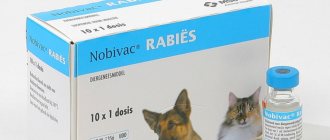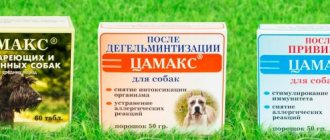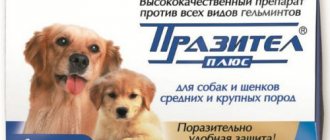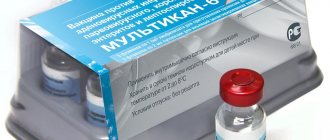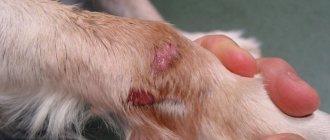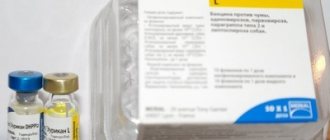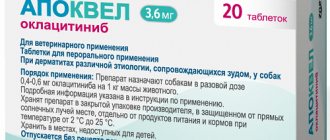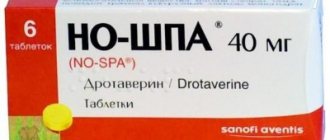Baytril (enrofloxacin) antibacterial solution for injection 2.27% for dogs
This page contains information about Baytril (enrofloxacin) antibacterial injection solution
2.27% for dogs for veterinary use.
The information on this page includes the following:
- Indications for the use of Baytril in dogs (enrofloxacin) in the form of an antibacterial solution for injection 2.27%
- Warnings and Cautions for Bactril (enrofloxacin) Antibacterial Injection Solution 2.27% for Dogs
- Directions and dosage information for Baytril (enrofloxacin) antibacterial injection solution 2.27% for dogs
- Baytril (enrofloxacin) antibacterial solution for injection 2.27% for dogs
This treatment refers to the following types:
Company: Bayer Animal Health
Content
1. General description 2. Action 3. Purpose 4. Dosage 5. Application features 6. Limitations 7. Negative consequences 8. Analogues 9. Reviews
Antibiotics are used for treatment of many infectious diseases in animals. When choosing medications, veterinarians give preference to those that are developed specifically for veterinary medicine. Among other antibacterial drugs, Baytril for dogs has proven itself well. It quickly destroys pathogenic microorganisms.
Description of the drug Baytril
Enrofloxacin (active ingredient baytril, antibacterial solution for injection 2.27% for dogs)
is a synthetic chemotherapeutic agent from the class of fluoroquinolones. It has antibacterial activity against a wide range of gram-negative and gram-positive bacteria. Each ml of Baytril solution for injection contains:
- enrofloxacin 22.7 mg
- n-butyl alcohol 30 mg
- potassium hydroxide for pH adjustment and water for injection, qs
Release forms
1 ml of medicine for animals contains enrofloxacin in an amount of 100 mg. The medication is available in the form of a solution for injections with different percentages (5 or 10%) and tablets. Methods of administration:
- oral;
- intramuscular.
Baytril can be mixed with food. An oral solution is indicated for the treatment of young birds. It is available in a transparent jar with a volume of 30-100 ml or ampoules of 1 ml. The medication is considered an “ambulance” in case of a sharp deterioration in the condition of pets. Baytril's instructions describe its following effects:
- antibacterial;
- antimycoplasmic.
The unique composition helps to destroy various types of bacteria in the shortest possible time. The drug can be prescribed by a veterinarian for salmonellosis, necrotic enteritis, Proteus syndrome, streptococcosis, viruses, and mixed infections. Baytril should not be given if the goat, dog or other animal suffers from a cartilage disease.
Other contraindications to therapy:
- convulsions;
- neuronal damage;
- pregnancy;
- the presence of microbes resistant to fluoroquinolones.
No cases of serious side effects have been reported in veterinary practice. If during therapy the functioning of the gastrointestinal tract is disrupted, it is recommended to replace it with an analogue. Self-administration of a new drug is prohibited. The prescription must be written by a veterinarian after examining the pet. Symptoms of overdose (lethargy, refusal to feed) appear when the doctor’s recommendations are not followed.
PHARMACHOLOGIC EFFECT
According to the instructions for use, drugs derived from quinolone carboxylic acids are classified as DNA gyrase inhibitors. The mechanism of action of these compounds is very complex and not yet fully understood. The site of action is bacterial gyrase, an enzyme that promotes DNA synthesis. The effect on Escherichia coli is the inhibition of DNA synthesis. It also leads to the cessation of cellular respiration and division. It can also disrupt the integrity of the bacterial membrane.
Enrofloxacin has a bactericidal effect and acts on both gram-negative and gram-positive bacteria. Minimum inhibitory concentrations (MIC) ensure sufficient accumulation of the drug in the tissues of the dog and the death of microorganisms.
Pharmacokinetics of Baytril in dogs
In dogs, the absorption and elimination characteristics of the oral formulation are linear (plasma concentrations increase proportionally to dose) when Baytril is administered at doses up to 11.5 mg/kg twice daily. Approximately 80% of an orally administered dose enters the systemic circulation unchanged. Eliminating organs, based on the time the drug is eliminated from the body, can easily remove the drug without evidence of accumulation.
The main route of elimination is through urine. Absorption and elimination characteristics beyond this point are unknown. Saturated absorption and/or elimination processes may occur at high doses.
Following an oral dosage for dogs of 2.5 mg/kg, baytril reached 50% of the maximum serum concentration after 15 minutes, and the maximum serum level was reached after one hour. The half-life in dogs is approximately 2 hours at this dose. Baytril is an antibacterial injection solution 2.27% for dogs.
List of other antibacterial drugs for dogs
- Trichopolum for dogs
- Study the use of ceftriaxone in dogs
- Instructions for use of Metrogyl for dogs
- Instructions for use of metronidazole for dogs. Explore the breadth of antibacterial effects of metronidazole in dogs
- Instructions for use of clindamycin for dogs (Clindamycinum)
- Doxyfine for dogs (instructions for use, doses, indications and contraindications)
- Instructions for the use of doxycycline in dogs
- Atovaquone for dogs
- Azithromycin for dogs
Contraindications to the use of the drug in dogs
Baytril is contraindicated in dogs with hypersensitivity to quinolones.
The use of Baytril is contraindicated in small and medium breed dogs during the rapid growth phase (2 to 8 months of age). Safe use of Baytril has not been established in large and giant breed dogs during the rapid growth phase. Large breeds can remain in this phase for up to one year, and giant breeds for up to 18 months. In clinical field trials using a daily oral dose of 5.0 mg/kg, there were no reports of lameness or joint problems in any breed. However, controlled studies with histological examination of articular cartilage have not been performed in large or giant breeds.
Under what conditions do chickens get sick?
- If you are breeding broilers, then you probably know that these birds have low adaptive abilities and can be kept without problems only in sterile conditions. Getting from the incubator to the poultry house, they encounter myriads of different microbes and bacteria. In this situation, they urgently need veterinary care.
- Another reason for illness and death is improper care of fragile livestock. The temperature in the room for newborn chicks should be maintained at 30°C, and a supply of fresh air should be provided. A lack of oxygen for chickens is a sure way to illness and the onset of mortality.
- We must not forget that in the first day after birth, the digestive system of chickens is not yet able to function fully and it must not be overloaded with excess feed. If this rule is violated, the food in the stomach will rot and inflammation of the gastrointestinal tract will develop.
- To ensure rapid growth and normal development of the livestock, it is important to carry out vaccinations in a timely manner. At the slightest sign of disease, sick chickens are isolated.
Dog safety
Adult dogs treated with oral Baytril at a daily dose of 52 mg/kg for 13 weeks had only isolated cases of vomiting and loss of appetite. Adult dogs receiving tablets and administration of the drug for 30 consecutive days with daily treatment of 25 mg/kg did not show significant clinical signs and had no effect on blood parameters. Daily doses of 125 mg/kg for up to 11 days caused vomiting, appetite, depression, difficulty ambulating in dogs, and death, while adult animals receiving 50 mg/kg/day for 14 days had clinical signs of vomiting and appetite.
Adult dogs treated with three intramuscular treatments of 12.5 mg/kg followed by 57 oral treatments of 12.5 mg/kg at 12-hour intervals showed no significant clinical signs or effects on clinical chemistry, hematology or histological parameters.
Oral treatment of growing puppies aged 15 to 28 weeks with a daily dosage of 25 mg/kg caused abnormal development of the carpal joint and weakness in the hind limbs. Significant improvement in clinical signs is observed after discontinuation of the drug. Microscopic studies revealed damage to articular cartilage after 30 days of treatment at 5, 15 or 25 mg/kg in this age group. Clinical signs of difficulty walking or associated cartilage lesions were not observed in puppies 29 to 34 weeks of age following daily treatment with 25 mg/kg for 30 consecutive days, nor in puppies 2 weeks of age on the same treatment schedule.
The drug does not affect circulating microfilariae.
No adverse effects on reproductive parameters were observed in dogs.
Reviews
Owners
Kirill, 31 years old, Blagoveshchensk : “Baytril was prescribed to our Pekingese after he was diagnosed with pneumonia. But after 2 injections, the dog became apathetic, refused to eat, stopped moving - he just lay there and that’s it. We immediately contacted the veterinarian. He said the dog was intolerant to the medication and prescribed a different antibiotic.”
Irina, 42 years old, Kaluga : “After the Baytril injection, the dog began to itch at the injection site. The next day the dog howled in pain after the injection. I had to give up the drug, so I can’t judge how effective this remedy is.
The drug was prescribed for purulent cystitis, but 2 injections were not enough. The doctor selected another medication.”
Veterinarians
Alexey, 37 years old, veterinarian, Rostov-on-Don : “Baytril is an effective drug that helps with many bacterial pathologies. But the medicine has many side effects, which dog owners often complain about.
Strict adherence to the doctor’s recommendations helps to avoid unpleasant symptoms. I don’t recommend giving injections yourself; it’s better to entrust it to a doctor.”
Victoria, 51 years old, veterinarian, Tambov : “I prescribe Baytril for dogs with urinary system infections. An effective medicine, but has side effects. I warn dog owners about this and recommend following the veterinarian’s recommendations.”
DRUG INTERACTIONS
Concomitant therapy with other drugs that are metabolized by the liver may decrease the rate of clearance of the quinolone and the other drug.
Baytril was administered to dogs at a daily dose of 10 mg/kg concomitantly with a wide range of other drugs, including anthelmintics (praziquantel, febantel), insecticides (pyrethrins), heartworm preventatives (diethylcarbamazine) and other antibiotics (ampicillin, gentamicin sulfate, penicillin) . Currently, there is no known incompatibility with other medicinal products.
Special instructions, storage, price
When using the medicine as a prophylactic orally, there is a risk of causing dysbiosis in an animal or bird. The problem can be prevented by giving a drug that restores the microflora in parallel with the antibiotic.
Advice! Drugs for dysbacteriosis can be bought at a regular pharmacy.
An unopened bottle of the drug is stored in the dark for no more than 3 years. After opening, the antibiotic loses its properties after 30 days.
Be sure to read:
Treatment of animals and birds with Biovit-80 for infectious diseases: instructions and price
The cost of a veterinary drug depends on the volume of the drug. A package of 25 ml costs about 300 rubles, 1000 ml - 1500 rubles. In most veterinary clinics you can purchase the product in ampoules of up to 5 ml, which will be cheaper if one-time use is required.
Warnings
For use in animals only. Keep out of the reach of children.
Avoid contact with eyes. If contact occurs, immediately flush eyes with plenty of water for 15 minutes. In case of contact with skin, wash skin with soap and water. Consult a physician if there is any irritation following exposure to eyes or skin. People with a history of hypersensitivity to quinolones should avoid this product. People are at risk of photosensitivity within a few hours of excessive exposure to quinolones. In case of excessive accidental exposure, avoid direct sunlight.
Side effects
Baytril is a potent drug, so side effects may develop while taking it. Most often they manifest themselves as nausea and vomiting, diarrhea, and loss of appetite.
If unpleasant symptoms appear, you should stop taking the medication, give your dog an antihistamine and contact a veterinarian. Symptomatic treatment may be needed.
If the medicinal composition is administered quickly, a compaction occurs at the injection site. This can lead to unpleasant consequences, such as hair loss. A specialist must give the injection, so it is better to go to the clinic.
Dosage and Administration
Baytril injection solution can be used as a starting dose of 2.5 mg/kg.
It should be administered intramuscularly as a single dose, after which Baytril tablet therapy should be started.
The lower end of the dose range was based on efficacy studies in dogs where Baytril was administered at a dose of 2.5 mg/kg twice daily. Targeted animal safety and toxicological studies were conducted to establish the upper limit of the dose range and duration of treatment. Use the drug within 90 days after the first puncture of the bottle. It is not permissible to use more than 20 punctures of a bottle with the drug.
Purpose
Baytril is used to treat a wide range of infectious diseases:
• respiratory organs – rhinitis, laryngitis, bronchitis, pneumonia;
• genitourinary system – inflammation of the bladder, glomerulonephritis and other infections;
• gastrointestinal tract – for colibacillosis, dysentery, etc.;
• other pathologies – streptococcosis, salmonellosis, phlegmon, septicemia, mycosis, etc.
The antibacterial drug is used in complex therapy for viral diseases to treat secondary infections and other pathologies caused by bacteria.

